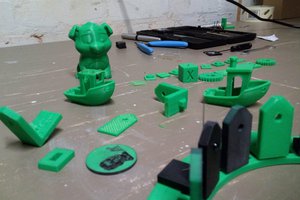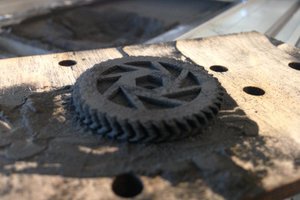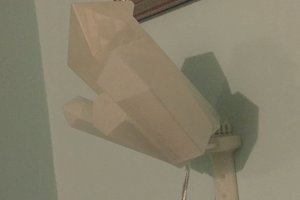Automata Music Sequencer
An automata music sequencer using cams, gears and pulleys to program the note sequence. Music generated by 555 square wave output.
An automata music sequencer using cams, gears and pulleys to program the note sequence. Music generated by 555 square wave output.
To make the experience fit your profile, pick a username and tell us what interests you.
We found and based on your interests.
B drum with two gears.stlStandard Tesselated Geometry - 3.06 MB - 02/20/2019 at 02:15 |
|
|
C drum with gear.stlStandard Tesselated Geometry - 2.11 MB - 02/20/2019 at 02:15 |
|
|
pulley drive gear.stlStandard Tesselated Geometry - 1.09 MB - 02/20/2019 at 02:15 |
|
|
switch holder B.stlStandard Tesselated Geometry - 1.04 MB - 02/20/2019 at 02:15 |
|
|
switch holder A.stlStandard Tesselated Geometry - 1.04 MB - 02/20/2019 at 02:15 |
|
When I got this idea it was based on a rotating cylinder like the ones in wind up music boxes only it would trigger notes on a 555 based squarewave synth that I had already built. The Sqonkbox. I knew that the cylinder would have movable cams that would trigger micro switches. The part that went through many variations in my head was how it all went together. I'm a musician so I was thinking 4/4 time. The drum would play 8 notes or two measures of quarter notes. Then I thought why not add a second drum. Then immediately thought a third drum with cams that sequenced the first two drums, but rotating at 1/4 he speed to allow the programming of phrases.
It all came together in my head, but how to implement it. Like most problems involving hardware hacking, it came to me upon waking up when my mind is fresh. The final build is what I envisioned in an instant one morning. Once I had that vision I had a plan. After that it was just a matter of spending about 10 hours designing it all in Sketchup. Once I had the drawings and converted then to .stl files it was time to start printing.
When I started I had one printer. A Hictop 3DP-11. It got a major workout printing the three main drums which took a total of over 30 hours! The printer started to have issues with the extruder feed gear and after several failed prints I knew it was time for some upgrades. However, I was short on time.
I decided to buy a larger better printer. I bought a Monoprice Maker Pro MK.1. After one day of use, I sent it back and did some more research. I then decided on the Creality CR-10S which I bought on Amazon. I set it up on the Saturday before the the deadline for this contest and had it printing parts by the afternoon. I stayed up til past midnight printing prototype parts and refining the design. I spent the following Sunday doing more refining parts and printing with both printers. I had since bought and installed a new extruderor the 3DP-11. By 1:30 am I had the final base board printing. It was at 48% when I went to bed.
Monday morning it was still printing as I left for work. I came home at 5:00 to a finished piece and began assembly. I stayed up until 1:45, getting the build to the point of needing only wiring and programming. This morning, I packed it all up along with a power supply and took it to my business. I own and operate an automotive repair shop. I finished up the wiring at my electrical work bench there. I inserted the cams in such a way so as to play an ascending and descending scale. By 11:45 it was operational. I posted a final picture to this blog and marked the project "complete".
There are over 60 3D printed pieces totaling well over 70 hours of of print time in this project. The printer was a $500 purchase and the upgrades to the 3DP-11 cost about $30. I used close to a kilo of filament. I ended up with a great new printer, a lot of new knowledge and experience and the satisfaction of completing a project I had envisioned on time for this contest. I pushed the limits and I came out on top.
It was well worth the investment in time and money. I hope this will inspire others in the same way.
Keep on hackin...
Dean, AKA Makerdino on HackAWeekTV.
The Automata Music Sequencer is complete and working! I was up until 1:30 AM last night and spent another two hours this morning finishing up the wiring and fine tuning it.
I've been at work on the sequencer all weekend. Saturday morning I received a new Creality CR-10S 3D printer from Amazon.
I sent back the Monoprice Maker Pro Mk.1. Too many issues and I didn't like the touch screen interface.
After a few hours of setup I had the CR-10S up and running and inside an enclosure made of coroplast.
I designed a few more parts in Sketchup and used both of my printers to produce them. I also worked out the base plate that everything will mount on and got that "sketched up". As I write this at 12:36 AM both printers are cranking out the final parts. The CR-10S has a 10 hour print of the base plate going while the 3DP-11 is printing some mounting brackets and micro switch mounts. Everything should be done just in time for coffee tomorrow morning.
Tomorrow evening is crunch time assembling everything and getting to work.
I've been busy designing and printing more parts this week. Also troubleshooting some 3D Printer problems. It seems my feed gear is wearing out. A good cleaning has helped and as I write this a 9 hour print is taking place in the Hack Shack.
I've printed the two drums that will sequence the notes. They each took about 14 hours to print.
I've also been printing more of the note cams. I have nine of each but I'd like to have 16 of each so I'll be printing more.
1/20/19
Today I began this project by working up a prototype of the drum that will hold the sliding cams that trigger the micro switches. Designed in SketchUp and printed on a Hictop 3DP11 printer.
The final drum will be about 100 mm in length and 100 mm in diameter. The cams will be made in three different lengths to correspond to a quarter note, half note and whole note. The part that slides back and forth in the drum will be the same dimension, only the length of the cams will change .
Pictured here is a proto cam that represents a quarter note. This was printed with ABS in draft mode with a 20% fill, print speed 100, bed temperature 80C, extruder temperature 240C.
Create an account to leave a comment. Already have an account? Log In.
I never really thought of music box drums as a cam system before, but of course that's exactly what they are. Cool!
Become a member to follow this project and never miss any updates

 johnowhitaker
johnowhitaker
 bfoz
bfoz

 cprossu
cprossu
Nice try but the rotation speed is too fast . Drums of that big size could produce longer time music if used at a slower rotation speed , like kids mechanical music boxes https://www.youtube.com/watch?v=dC28aklyHnE